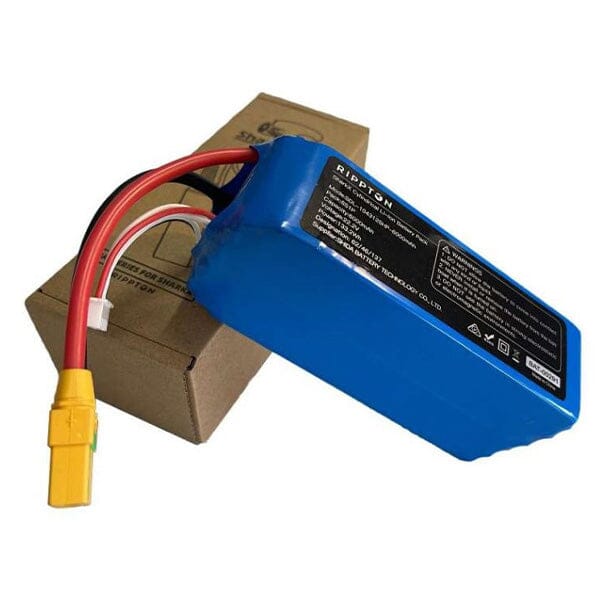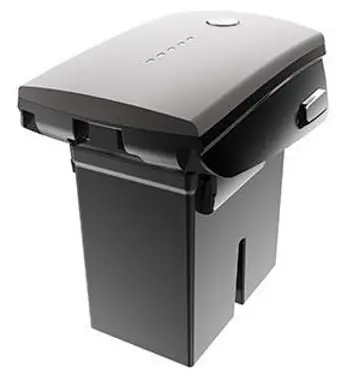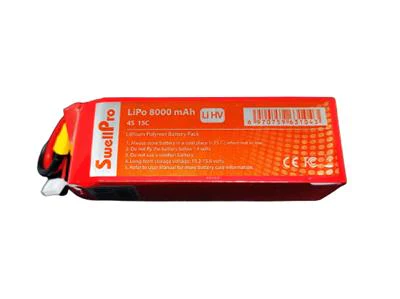Your fishing drone battery is one of the most important pieces of your fishing drone kit, helping to keep your trusted bird in the sky. But it’s important to remember that these batteries do need a bit of regular TLC, and looking after them is essential to preventing some of the challenging aspects of drone usage. This battery maintenance guide simplifies battery care for all enthusiasts – your ticket to hassle-free drone adventures.
The chemistry of all LiPO batteries irrespective of the brand is the same so they should therefore be cared for in much the same way. The important points for battery maintenance are covered here, with some specific considerations for those used in fishing drones.



ALWAYS respect the C.A.R.E.D. principles for practising responsible safety and disposal.
NEVER store batteries with a full charge (if left for more than a couple of days), and NEVER store batteries with little or no charge.
As a rule of thumb, if you are storing your batteries for any more than a couple of days, ALWAYS ensure batteries stored are around 50-60% charge.
MAKE SURE you use the correct charger and correct settings for your battery BEFORE attempting to charge the battery.
DO NOT drain your battery. Batteries should not be discharged to any less than about 20% of the full battery capacity at any time.
IF you ever have a battery that is swollen or is damaged in any way, DO NOT USE IT, and dispose of it safely as soon as possible.
Never Leave your batteries unattended while they are being charged & DO NOT charge overnight. Really important because there is always a small risk of fire during the charging process.
Always charge and store your batteries in a Thermal resistant case. These cases are made from fire resistant material and will minimise any damage IF your battery ever catches fire.
Breaking down some of the more important points around your battery, below we discuss things in more detail and answer some questions that are often asked:
Some fishing drone batteries come with a BMS, while others don’t. Most drone fishing batteries up until now are non-BMS batteries. These are cheaper buy and simpler to manufacturer, as they don’t have the additional electric circuit of BMS Based Batteries.
Batteries with a BMS are normally encased in a plastic casing (like in the image below), but it’s worth noting that sometimes even batteries that are in a casing don’t have a BMS.
A BMS on your battery generally take better care of managing your battery and often will also naturally trickle discharge your battery much faster than a LiPO battery when not in use, and also a BMS battery normally has LED Lights to help indicate how much battery charge is left, which can be useful.
As related to fishing drones, you don’t normally get a choice of whether to use a BMS or not as it’s built right into the battery when you buy it.
This is another question that has come up in the last couple of years. Before this there were only Lithium Polymer or LiPO batteries, then the Lithium High Voltage or LiHV Batteries came along.
Both LiPO and LiHV are similar in some ways however the LiHV batteries have a higher maximum voltage per cell than the regular LiPO battery cells meaning a higher overall voltage for the battery. In general terms this means more battery life, because as the drone draws battery current from the battery the volts within the battery deplete until it is near empty. For example, this is why two similar batteries (but one is a LIPO and one is a LiHV) with the same number of cells and same capacity are rated at different voltages on the battery – which is called the nominal voltage, normally 3.7V per cell for the LiPO and 3.8V per cell for the LiHV (see more information on this below).
A rule of thumb here is that LiHV batteries generally need more care and are more prone to malfunction or have issues like swelling.
Speaking generally it is best to only use LiPO batteries in drones that were made for LiPO’s and LiHV batteries in drones that originally came with LiHV batteries. The battery chemistry in these batteries is slightly different.
One of the big issues around interchanging a LiHV and LiPO batteries is that you CANNOT use the same charging settings for both.
Normally the charger will show “LiPO” or “LiHV” on the charger display. You CANNOT use the same settings for both. One of the important reasons for this is that you should not charge LiPO Batteries upto any more than 4.2V per cell maximum, whereas the LiHV Batteries can be charged to 4.35V per cell. Attempting to charge LIPO batteries to any more than 4.2V can be dangerous, so be warned. Please consult a battery and charging expert for more information on this.
Many Fishing Drones these days come with a Balance Charger. This is good, because a balance charger will not only charge your battery but it will also balance the cells in your battery. All Lithium Batteries are made up with a number of individual cells all connected together. From time to time, through charging and discharging these cells, the voltage held in each cell can become unbalanced or uneven which can litterally stop your battery from charging at all (the charger will often give you a warning and as a safety precaution it won’t charge the battery)
Thankfully if you have a balance charger, then as you charge your battery using a balance charger just before the charger reaches 100% charge, it will balance the cells voltage.
It’s really important to get to know the settings on your Battery charger so that you never get the settings incorrect when trying to charge your battery.
Another helpful feature on many fishing drone chargers is a “discharge” or “storage” setting, which lets you be able to discharge the battery if you are not going to use your drone for a while and need to store your batteries. As we have mentioned above if you are going to stop your Lithium batteries then you will need to have them on about 50% charge, and a good way to do this is use your charger to do this. By the way we also sell a handy discharge stick, designed to slowly discharge your battery down to storage level (for use on many brands), it can be found HERE
Remember also that your battery will is always be live, so when you go to charge it, remember not to touch any cable connectors to the battery that you don’t intend to plug in as this can cause a short. The same goes for the charger itself – it’s a good idea to ONLY plug into the wall and turn the charger on ONCE you have all the charging leads already plugged in correctly to the charger and battery.
Some of the important information you want to make sure are set correctly on your charger display before attempting to charge your batteries include:
Consult your user manual for more information on doing this or to find out more information about your particular charger.
These terms refer to the Number of Cell packs that make up your battery. 4S means it has 4 cells in series, and 6 cells means it has 6 cells in series. It also means that a 6 Cell (6S) battery has a higher nominal voltage than a 4 cell (4S) battery. So the two common battery types used in fishing drones are 4S1P, or 6S1P.
All Drone Battery LIPO cells have the same nominal voltage of 3.7 volts. So to calculate the rated battery voltage you simply multiply the battery cell voltage by the number of cells, so if we have a 6S LiPo battery, this battery is rated at 22.2 volts nominal (or 3.7v x 6), and 4S LiPo would be rated at 14.8 volts nominal.
The Numbers are slightly different if instead we are talking about a LiHV Battery. As described above the voltage of a LiHV battery are slightly higher than the LiPO Battery. In the case of the LiHV Cells they have a nominal rating of 3.8 volts, so this means that if we have a 6 cell LiHV battery, then it’s 3.8v x 6 cells = 22.8 volts nominal. For a 4 cell battery LiHV Battery the nominal voltage is therefore 15.2 volts.
It’s also really important to note that you should not drain your battery any lower than 3.6v per cell, or 20% of the batteries full capacity otherwise you could permanently damage it.
mAh simply refers to the capacity of the battery (measured in Ampere hours). The more capacity that a battery has, and therefore the bigger the number (in mAh) and generally speaking the more flight time you are going to get in your fishing drone, which just makes it sound like you should just go with the biggest capacity battery possible.
HOWEVER the big limiting factor here is that this also means that the battery is going to be larger and heavier as you go up in capacity. Of course there is only so much size and weight that any drone can handle while it flies, and often what happens is that a particular drone can handle upto a certain capacity and weight of battery, and then if you go any more the maximum flight time of that drone actually begins to drop – given the additional weight.
The short answer to this is no it’s not worth trying it (we are talking about if your drone battery has a capacity of 5000mAh to 8000mAh). Of course the reason that some people think about charging their battery at 5 amps or more, as in theory this means you might be able to charge your battery faster, HOWEVER doing so runs the risk of causing a fire or explosion, and once a Lithium battery fire starts it’s very difficult to extinguish.
Our recommendation is to charge your main drone battery at 3 amps. This not only reduces the risk of fire, but it also will prolong the useable life of our battery over the long term.
As a note, if you are wanting to charge your smaller 1800mAh or 2000mAh battery (like found in a Swellpro SD3 remote controller) then don’t charge these batteries at any more than 2 Amps.
It’s important to remember that storing your LiPO on LiHV Batteries on full charge is not a good idea. If you charge your battery up fully but then don’t end up using your drone straight away (ie. within the next couple of days), then it’s a good idea to discharge the battery down to storage voltage level. Storage voltage is around 3.85V per cell for a LiPO (which is about 55% of battery capacity).
Also optimal battery storage temperature is around 21 ℃. You should not let your battery be stored much more than this, OR conversely let your battery get too cold when it is being stored as both of these situations can damage the battery, and could even lead to fire.
Discharging can either be done by simply using the battery in your drone, using your charger (some chargers have the discharge feature), or using a discharge stick (like the one we sell HERE).
Apart from the original batteries that come with your drone when you purchase it, there are literally hundreds of brands of LiPo and LiHV batteries on the market, and so they are easy to get and are often cheaper to buy than purchasing spares of the original brand, however be warned!
Firstly, many of the after-market batteries available can be of questionable quality which can have disastrous implications if you go and use them in your drone – and often you don’t know until it’s too late. Secondly if you don’t get the type of battery or specification right, again this case cause big problems. Thirdly, If you have a problem with your drone and you are using third party batteries this can instantly void your warranty on the drone.
So in summing up we think it’s best to steer clear of third party batteries and instead stick to the originals.
It’s also important to mention that ANY LIPO or LiHV Drone Batteries from any manufacturer can have problems from time to time no matter the manufacturer and quality of the battery, and this can related to the Lithium based battery chemistry being used in all of them, or lack of battery maintenance. The best way to minimise issues is to take good care of your batteries and at minimum, follow the 9-point battery charging & storage checklist for basic maintenance above.
Prioritise responsible safety: yours, the safety of others, and care for our environment – ensure you batteries are C.A.R.E.D. for respecting these principles:
Careful treatment: Avoid subjecting batteries to extreme temperatures (including away from direct sunlight), moisture*, punctures or crushing.
Avoid over charging or over discharging: Never leave batteries unattended while charging, and consider using a flame-proof charging bag.
Right charge: Always use the right charger and correct settings for your battery before attempting a charge.
Examination: Look for swelling, leaks, or damage, and replace damaged batteries immediately.
* Batteries used for drone fishing should be built for marine environments and durability.
We trust you enjoyed this article about Lithium battery care & maintenance, if you happen to purchase any drone or battery from us here at Drone Fishing NZ it is very important that you follow the manufacturer’s instructions along with the above information.
Here’s a great video on looking after a Splashdrone FD1 Battery from Swellpro New Zealand:
$2,699.00 Original price was: $2,699.00.$1,999.00Current price is: $1,999.00. incl GST
$3,999.00 Original price was: $3,999.00.$3,499.00Current price is: $3,499.00. incl GST
A direct line to your inbox with drone fishing news, tips & product reviews. Get access to our monthly member only discounts, sign up to become a Drone Fishing NZ Member now!"
A direct line to your inbox with drone fishing news, tips and product reviews.